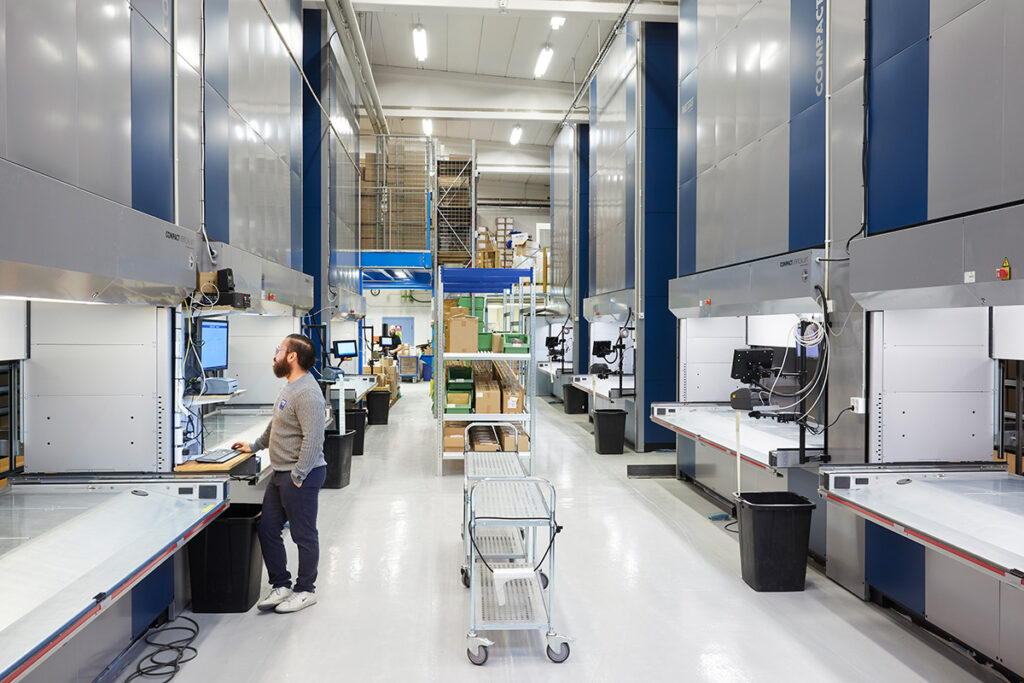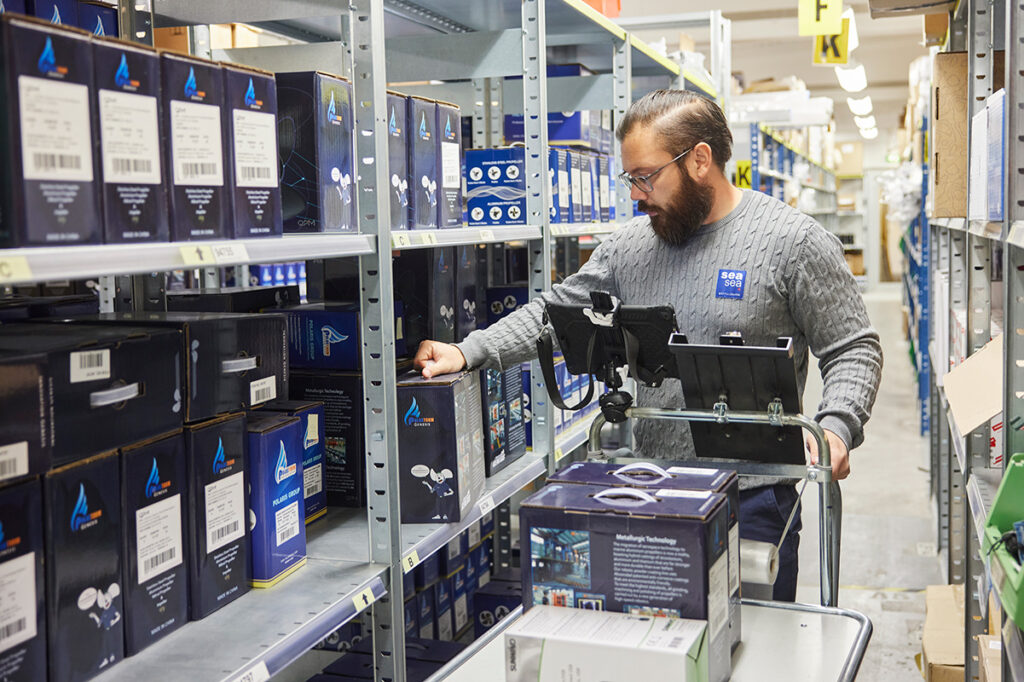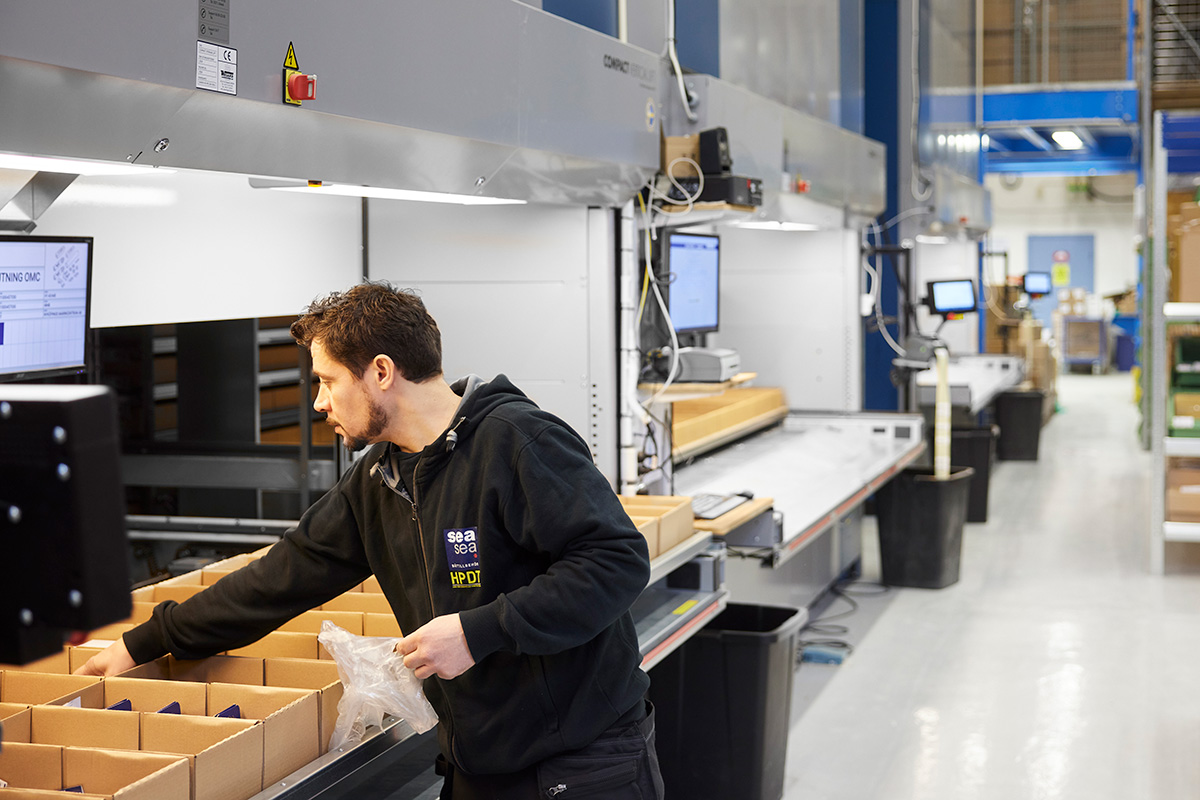Byggplast & Båtprylar’s revolutionary lift journey
Since 2018, Byggplast & Båtprylar has conducted a comprehensive overhaul of their warehouse, installing seven Compact Twins and a customised version of Compact Store. A building that used to be able to house 7000 unique items now has a capacity of 9000, of which 4000 are held in vertical storage lifts. The remaining 5000 items are held in traditional pallet racket, which are controlled from the same system. Overtime has been eliminated, the need for additional staff significantly reduced, checking has been exemplary, and picking errors have been reduced to a minimum. Follow us on their journey.
How do you use 3000 m2 in the best possible way?
Byggplast & Båtprylar Sverige AB is a wholesale supplier to Seasea, a marine products specialist with a retail presence throughout Sweden, from Malmö in the south to Luleå in the north. The chain consists of 10 stores that are run by Seasea, and a further 20 operated by franchisees. The company also sells boat accessories to boatyards up and down the country, to other selected resellers, and directly to consumers through its e-commerce channels. For the past few years, Byggplast & Båtprylar has been an independent company within the Hjertman Group.
The company has its head office and warehouse in Segeltorp, located just off the E20 in Stockholm. A fantastic position for the well-established retailer of boat accessories that has been in business since 1979. In addition to the store, the property, which covers a total area of 4700 m2, is also home to the company’s head office and warehouse, which takes up 3000 m2. With such an excellent geographical position, continually increasing sales but limited storage space, it’s a matter of finding an intelligent way of using the area you have at your disposal.
Per Tengman, Logistics and IT Manager, tells us more:
“We sell all manner of products related to boat life, but only accessories and not boats, although we do have a limited range of dinghies. There is considerable interest in our products, which has seen us increase our turnover year on year. Our sales are highly seasonal, going through the roof in spring and summer, which means that we have to keep as many items as we can in our warehouse. We were forced to find a more efficient storage solution.”
Gradual warehouse optimization using 3 + 2 + 2 Compact Twin
“The choice of Compact Twin was a simple one. We fell in love with the twin function, which means that the lift can handle two load trays at the same time. Picking speed has more than doubled as it is possible to pick from one tray whilst the system is loading the next. In addition, Weland Solutions gave a good presentation, painting themselves as a serious player, and are very easy to communicate with. We ordered the first three lifts in 2018. The positive impact they had was so revolutionary that we ordered two more in 2020, and a further two in 2021. With seven Compact Twins at our disposal, we have now achieved the most optimal storage solution for our range and limited storage space, which makes us extremely happy,” says Tengman.
Careful preparation pays off
“Preparation is essential if lifts are to be integrated in warehouse management in the fastest and best way. Peter from Weland Solutions paid us a visit before the new system was brought online and discussed ideas about which items would fit where. Naturally, the size and weight of an item have a significant bearing on what is put on the storage lifts, but frequency and likelihood of theft are also important factors,” says Tengman.
“You have to realise that the immense task of integrating a storage lift is something that the company has to do itself. We started by producing a report about how all our items are sold, classifying them as either A, B, or C. In the course of this work, we had to remember to go out and physically check how big the items actually were to ensure that they occupied the correct position on the loading tray. We did all this work before the lifts arrived,” adds Tengman.
“We now have everything from small slotted screws to exclusive autopilot systems that are as large as moving boxes, in the lifts. By sorting items according to frequency per tray, we have increased picking speed even further. We decided to supplement the loading trays with simple corrugated cardboard drawers, as we believed we would need to make changes after a while. However, it turned out that we didn’t need to do that and they’re still serviceable,” says a smiling Tengman.
Change didn’t happen overnight
“The staff’s fear of change, learning the system and how incoming deliveries would be handled, were major challenges to overcome. Despite the doubts, everyone has learned what do do without any problem, and now things are incredibly positive,” says Tengman.
“But it’s about understanding that it takes quite some time to bring the lifts in whilst still ensuring that the day to day operation of the business continues unabated. As you would expect, the first three lifts took time to install, nearly two months. The others probably took less than 3 weeks. Incoming deliveries happen in the same way, although the other way around. We created pick lists to deliver into the lift and introduced them bit by bit. Now, deliveries go straight into the lift so that the entire balance of product is there. We have also ensured that a lot of storage is on conveyors in order to guarantee that we always fill from behind,” says Tengman.
Big advantage having the same system throughout the warehouse
“In the beginning, we only used Compact Store for the vertical lifts. In 2020, through the implementation of a custom solution, we also started to use Compact Store for everything that was on pallet racks. This means that we now don’t have to produce hard copy picking lists and can sign off on orders from both racks and lifts using a tablet. Because we have integrated Compact Store with our M3 business system, all picks are automatically registered. We have also allowed the marketing department to add pictures of each item in the system, making it easy for the picker to identify them. This has enabled us to reduce the number of rack picking errors to a minimum, which has made a big difference,” says a satisfied Tengman.
“Our entire warehouse is now very space efficient and split into three zones. Zone 1 for smaller items, zone 2 for heavy truck goods, and zone 3, which is home to our seven Compact Twin systems. Being able to pick multiple orders at the same time is a major benefit, and something we couldn’t do with the old paper system. An order may comprise picks from all zones, which are then to be consolidated in a single large box during packing. The system also shows where in the picking loop picking should begin in order to make work as efficient and with as few steps as possible. This saves us a significant amount of time and effort, and we have set up the warehouse so that 40% of picking is made from the lifts,” says Tengman.
Fewer staff easily handle a broader range of products
“In addition to being able to expand our product range, we are now also able to handle the demands of our high season using fewer seasonal employees than ever before. In spite of this reduced workforce, our employees don’t need to work overtime, which was a common occurrence in the past. Now, one person can do the job of three, and if things start to heat up, we just put another person on the lifts. This means that they can do twice as much and still pick efficiently without crashing into each other,” concludes Tengman with a smile.




